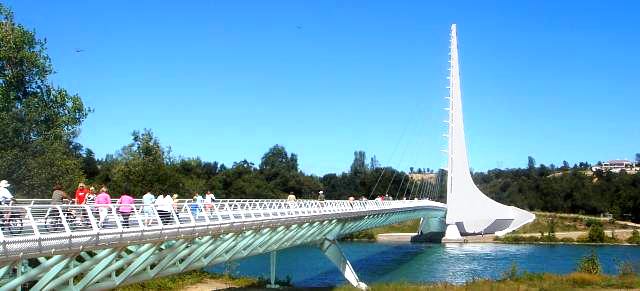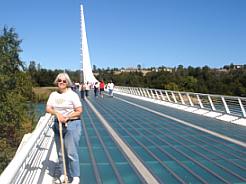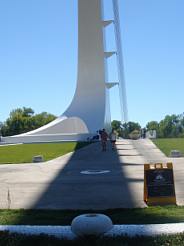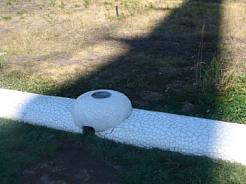Sundial Bridge
A Balancing Act
Redding, CA
September 16, 2006
 All across America, cities are trying their best to create attractions which will draw in crowds that will enhance the economy of the community.
Of the dozens of cities and towns along the Sacramento River, the City of
Redding was no different. Back in 1995, the city fathers were exploring
the development of the land in the Turtle Bay Exploration Park, which runs
on both sides of the river. A footbridge bridge was needed to connect the
planned Arboretum on the north bank with a planned museum on the south
side, and a search was ongoing to find just the right structure that would
bring attention to the area. John Mancasola vice-president of the McConnell foundation
who was in charge of the project had $3 million to build a bridge, but was
having problems with
All across America, cities are trying their best to create attractions which will draw in crowds that will enhance the economy of the community.
Of the dozens of cities and towns along the Sacramento River, the City of
Redding was no different. Back in 1995, the city fathers were exploring
the development of the land in the Turtle Bay Exploration Park, which runs
on both sides of the river. A footbridge bridge was needed to connect the
planned Arboretum on the north bank with a planned museum on the south
side, and a search was ongoing to find just the right structure that would
bring attention to the area. John Mancasola vice-president of the McConnell foundation
who was in charge of the project had $3 million to build a bridge, but was
having problems with

the dissention over which of two American design companies
would get the contract. In hopes of getting the project moving again,
Mancasola contacted Spanish architect Saniago Calatrave in Switzerland.
The result was a bridge design that would stun the State, and give Redding the
very attraction it had so desired. Although the final cost would run over
$23 million, it was still worth it according to Mancasola. Of major
concern during the planning stage was the river below. The Federal government had sunk millions of dollars into protecting
the salmon
spawning grounds at Turtle Bay. The city needed a span that would not plunge concrete
stanchions into the fish nursery. The bridge is a balance of weight and
counter weight of equal amounts. At the south end of the bridge is a
gigantic sun dial reaching 217 feet into
over
$23 million, it was still worth it according to Mancasola. Of major
concern during the planning stage was the river below. The Federal government had sunk millions of dollars into protecting
the salmon
spawning grounds at Turtle Bay. The city needed a span that would not plunge concrete
stanchions into the fish nursery. The bridge is a balance of weight and
counter weight of equal amounts. At the south end of the bridge is a
gigantic sun dial reaching 217 feet into  the air. tilted 41 degrees away
from the bridge floor. The steel in the sundial weighs over 700 tons and
would come crashing to the ground but for the 14 steel cables which run from
various parts of the dial, to various points along the bridge. With the
weight of the dial and the weight of the bridge nearly equal, the entire
structure became balanced. The point of balance at the base of the dial,
is a 1 foot diameter bearing. The cables are asymmetrical, running down
only one side of the bridge. This is highly unusual for a suspension-type
bridge. It is truly an engineering feat to keep it from dropping on the
non-cable side. Adding to the spectacular appearance is the bridge
flooring.
the air. tilted 41 degrees away
from the bridge floor. The steel in the sundial weighs over 700 tons and
would come crashing to the ground but for the 14 steel cables which run from
various parts of the dial, to various points along the bridge. With the
weight of the dial and the weight of the bridge nearly equal, the entire
structure became balanced. The point of balance at the base of the dial,
is a 1 foot diameter bearing. The cables are asymmetrical, running down
only one side of the bridge. This is highly unusual for a suspension-type
bridge. It is truly an engineering feat to keep it from dropping on the
non-cable side. Adding to the spectacular appearance is the bridge
flooring.  The 700 feet of bridge deck is made up of 400 tons of steel
holding up 2,245 opaque glass panels of 10 sq. feet each. At night, lights
from underneath illuminate the glass panels into a soft green glow. The
sundial, unfortunately fell short of a working time piece. the height
casts shadows far greater than the surrounding land would allow for a proper
marking off of the hours. However, between 11:00AM and 3:00PM you can find
the white round stones displaying the number of each of those hours. Accuracy,
as with all sundials is met with varying amount of success, except on the
summer solstice on June 21st. when it is quite accurate. It is quite an
experience to stand in the middle of the span and look out over the river
knowing you are standing on glass. For engineering buffs this is a must,
for the rest of us it is a great place to visit for an afternoon.
The 700 feet of bridge deck is made up of 400 tons of steel
holding up 2,245 opaque glass panels of 10 sq. feet each. At night, lights
from underneath illuminate the glass panels into a soft green glow. The
sundial, unfortunately fell short of a working time piece. the height
casts shadows far greater than the surrounding land would allow for a proper
marking off of the hours. However, between 11:00AM and 3:00PM you can find
the white round stones displaying the number of each of those hours. Accuracy,
as with all sundials is met with varying amount of success, except on the
summer solstice on June 21st. when it is quite accurate. It is quite an
experience to stand in the middle of the span and look out over the river
knowing you are standing on glass. For engineering buffs this is a must,
for the rest of us it is a great place to visit for an afternoon.
*** THE END ***
